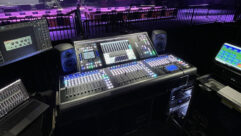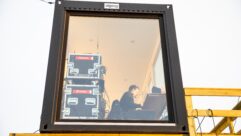What’s Wrong With Wireless?
Unreasonable expectations, technical hurdles, and security issues have prevented wireless projection from going mainstream. Are we any closer to a solution?
It’s getting tough to find a café, airport lounge, or office building that doesn’t have a “WiFi” wireless local area network (LAN) for easy Internet access. It’s also getting tough to buy a laptop that doesn’t have built-in WiFi for connecting to those wireless LANs. Those two trends should bode well for wireless pro AV products: As more people get used to WiFi at work and home, that awareness should create a sales opportunity for WiFi products such as projectors and DVD players.
Or at least that’s how the market was supposed to play out. Instead, wireless projectors are still a niche play. “It’s still limited to the single user in a corporate environment who’s learned how to use the software and become comfortable with it,” says Henry Barnston, an account executive at CCS Presentation Systems, a Los Angles-based AV integrator. “Basically he’s still an early adopter.”
So far, wireless projectors haven’t shown signs of breaking out of single-user mode. “I don’t really see enterprises adopting this,” says Doug O’Connor, another CCS account executive. “I see individuals adopting it. I don’t see whole groups, or departments, running after it.”
Part of CSS Presentation Systems’ sales team, Doug O’Connor, account executive, David Riberi, vice president, and Henry Barnston, account executive, demonstrate wireless presentatation capabilities. Shown running a PowerPoint presentation on a laptop wirelessly linked to a ceiling-mounted projector in their corporate boardroom in Los Angeles, the group embraces the potential of this technology but admits there are still a few technical obstacles to overcome.
Vendors say that wireless projectors are catching on in some markets. “House of worship is an increasing trend,” says Jane Poon, product marketing manager at Toshiba Projector. Poon also has noticed growing adoption in the education market — the opposite of what Panasonic has seen. “I thought it would be more popular in schools, but they don’t like the security aspect of somebody fooling around with it, and students tend to go down that path,” says James Holzel, product line business manager for projectors at Panasonic.
Convenience’s tough sell
In the eye of the beholder, wireless’ beauty is its convenience. Here are some examples of how it’s commonly used in a conference setting:
- A speaker’s laptop wirelessly connects directly to the projector during the presentation. This approach eliminates the time spent fumbling with cables between presentations. The catch is that connecting to the wireless projector has to be a seamless process — or else the task can take up just as much time as plugging and unplugging cables.
- In a collaborative meeting, the projector serves as a hub for multiple laptops, connecting directly to each of them and toggling between presentations. Depending on the projector, multiple presentations can be displayed onscreen simultaneously. For example, Panasonic has a new model that can tile up to 16 presentation feeds at once. The projector uses wireless technology to connect to a LAN access point in order to retrieve a presentation stored on a server or on a PC connected to the network.
That convenience is why vendors are adding more wireless models to their projector line-ups. NEC, for example, currently has eight wireless projector models, while Panasonic added two models in April — to make a total of four.
Not everyone is sold on that convenience, however. A major caveat is that it varies by the application. For example, if the projector is in a conference room used only by employees, then their laptops can be loaded with the software necessary to quickly find and connect to the projector. But that’s rarely the case for a projector in a more public place, such as a convention center meeting room.
“In this situation, most users won’t have wireless software on their notebooks, so they won’t be able to use the projector,” says Bob Guentner, product marketing manager at NEC. “It’s still easier to simply plug into the projector.”
PICTURING COVERAGE
The new 802.11g wireless standard has an advantage over its older sibling, 802.11b: more channels to choose from. That translates into greater ability to avoid performance-hampering interference by simply picking a clearer channel.
On the down side, 802.11b and 802.11g share the same chunk of an unlicensed 2.4 GHz spectrum — a band that’s also home to devices such as cordless phones, surveillance cameras, and microwave ovens. That crowding creates some wild cards for AV integrators: If a wireless projector is installed here, will it interfere with the client’s access points over there, and vice-versa? And if the projector needs to connect to the client’s wireless LAN in order to retrieve presentations, how can you tell whether this location is in range of an access point?
One solution is tools, such as Cognio’s ISM Sensor, that sniff the airwaves to build a list of signals that could interfere with the projector’s performance. Another is tools such as AMX’ Wireless Site Survey, which uses information such as floor plans to predict the range of a WiFi signal. (For more information on Wireless Site Survey, see the “Tech Tips” section of the October 2004 Pro AV on page 13.) Some enterprises already own these types of tools, so it’s worth checking to see if the client can provide any coverage and interference information to help guide the installation and configuration.
The ideal situation would be to mimic public “hot spots.” At places such as cafés, hotels, and airports, users simply turn on their laptop, which then sniffs the airwaves to create a list of available 802.11 access points so the user can pick one to connect to. “If it were that easy to connect to a projector, then we’d be selling a lot more wireless systems,” Barnston says.
Vendors have tried various things in an attempt to make the connection process user-friendly. Toshiba, for example, includes client software on its laptops and Tablet PCs that provides a radar-like view of available 802.11 equipment, including projectors. “That’s what we’re hoping becomes universal across all brands of laptops,” Barnston adds.
Until that happens — which is as much a question of if as it is when — wireless projectors won’t be able to fully leverage the convenience factor, which is supposed to be a major selling point. In that utopia, a salesperson could walk into a customer’s meeting room, immediately and effortlessly connect to a projector, and give the presentation. “That’s going to be a huge difference,” Barnston says. “That’s one of the big obstacles right now.”
Convenience versus security
Convenience raises another issue: security. Simple connections aren’t always the safest. In WiFi, one example is “ad-hoc” mode, where two devices (such as a laptop and a projector) are configured so that they can communicate directly with each other rather than using a network as an intermediary.
Ad-hoc mode creates security risks. “Corporations are wary of it,” Holzel says. “Opening up your computer is a security issue.”
For example, visitors who don’t know much about wireless might have a client’s AV or IT staff put their laptop into ad-hoc mode to do a presentation, but then fail to shut off that setting afterward. As a result, when they later power up the laptop in a public place — such as the airport before the flight home — other laptops can connect to it and access information stored on it. If the laptop in ad-hoc mode is connected to another network, such as plugged into a wired LAN, the hacker could come in through the wireless host and get into the wired network. That’s why some government agencies require laptops to have software that automatically locks out all other connection modes when one is in use.
Sound complicated? It is. But it’s also an example of some of the issues AV integrators need to anticipate when working with wireless — as well as the client’s IT department.
Indeed, AV integrators say that some users prefer the ability to connect to a projector and a network simultaneously — such as the ability to pull up a website during a presentation — even though their company policy might consider that a security risk.
“For two years we’ve been asking manufacturers’ reps to come in here and do that,” O’Connor says. “I can’t tell you how many times people have come in here and said, ‘We can do that,’ and then they can’t. There have been all these configuration issues and obstacles pulling us in different directions and keeping us from enjoying the full benefit.”
It’s here that a vendor’s software can make a difference in terms of balancing security and convenience. Panasonic’s system, for example, changes laptop settings only temporarily. “When you open Wireless Manager, it freezes all of those settings and then opens an ad-hoc connection to the projector,” Holzel says. “When you close down, it reinstates all of your settings.”
Another common security concern is whether someone can hijack a projector, such as a protester sitting outside a conference room, connecting to the projector and feeding a video that’s critical of the company or person presenting. Some vendors have locked out that risk. “Our wireless projectors ship with utility software that gives me the ability to control interference, so no one can take over the presentation and pop up theirs,” Poon says.
Need for speed
The vast majority of pro-quality wireless projectors and players use 802.11 WiFi technology, which has a range of about 300 feet, depending on factors such as walls. Why WiFi? The main reason is that most laptops sold over the past year —particularly models aimed at the enterprise market —have WiFi built in, so wireless projectors can leverage that installed base. (Some vendors are exploring alternative technologies, such as ultra wideband. For more information on WiFi alternatives, see “Ultra Wideband Doubles the Speed of WiFi,” on page 64 of the August 2003 issue of Pro AV.)
At the same time, as more laptops use WiFi, chipset vendors such as Intel have to crank out more 802.11 hardware. As volumes go up, prices go down, so it’s easier for pro AV vendors to push WiFi deeper into their product lines.
Most laptops and wireless projectors use 802.11b, which has a maximum throughput of 11 Mb/s. Newer models use 802.11g, which has a peak rate of 54 Mb/s, so it’s better suited for bandwidth-intensive applications such as smooth slide transitions in PowerPoint. “With 802.11g, we can do motion and sound streaming using MPEG files,” Holzel says.
Another benefit of 802.11g is that it’s backward compatible with 802.11b, so a presenter with an 802.11b laptop can connect to an 802.11g projector. The catch is that in those types of connections, the link reverts to 802.11b speeds because that’s all that the laptop can handle.
Another caveat is that regardless of whether it’s b or g, about half of 802.11’s bandwidth is eaten up by housekeeping-type communications. So even though 802.11g supports 54 Mb/s, only about 27 Mb/s is available for the multimedia feed. (In the case of 802.11b, it’s about 5.5 Mb/s.) The remaining 27 Mb/s also gets whittled away by interference, walls, and the distance between the laptop and the projector.
Bandwidth is one of the reasons why wireless projectors are only now starting to build a following. Wired projectors set a high bar in terms of response time and video support, and even with compression and other proprietary tweaks, 802.11b has struggled to live up to those performance standards.
“B has the bandwidth issue and the delay,” O’Connor says. “The way that transitions loaded was such a setback from what they were used to with a hardwire connection. G is something that we can sell much easier. It’s a noticeable improvement. G definitely is better than b — way better.”
That assessment begs a question: Should vendors have waited until mid-2003, when 802.11g chipsets first became available, to add wireless to their projectors? It’s a fair question, partly for vendors’ own interests: If poor-performing 802.11b products soured the market for wireless projectors, 802.11g models would be a tough sell because they’d have to overcome a bad reputation before they could even begin to sell on their own merits.
It’s unclear whether first-generation products have cut into the potential for the latest crop. What is clear is that as the price premium shrinks, and performance improves, wireless projectors are finally in a position to tap a wider market.
“We tell people that if it’s a question of a few hundred dollars between buying one that’s wireless and one that isn’t, why not get the wireless one?” O’Connor says. “Then as that progresses, you’ll be in the driver’s seat — and you won’t be trading in your projector when you have to have wireless.”
What about upgrading? Can the wireless hardware on a projector be replaced as better 802.11 standards develop? It depends on how the vendor builds wireless support into the projector. If the WiFi radio is a chipset built into the projector, then you couldn’t upgrade to a completely different version. If the WiFi radio is a PC card modem that plugs into a slot in the projector — as is the case with at least some manufacturers’ projectors — then you could upgrade to a new version. The irony is that that flexibility can cut into wireless’ value proposition: If you’ve got a PC card slot, why not just use a storage card to transfer the presentation between the laptop and the projector?
Tim Kridel is a freelance writer and analyst who covers telecom and technology. He’s based in Kansas City and can be reached at[email protected].










